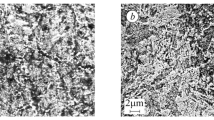Conclusions
-
1.
In the metal near cracks specific structural changes were found, viz., the formation of zones with refined or coarsened, oriented or equiaxial grain, migration of grain boundaries, which is the consequence of plastic deformation in operation.
-
2.
The following types of damage were discovered: macrodamage and microdamage of metallurgical origin; operational wedge-shaped and oval microcracks on the grain boundaries.
-
3.
Microdamages of metallurgical origin, of oval shape, are preserved in the process of operation and are not sources of crack nucleation.
-
4.
Inhomogeneity of the structure gives rise to zones of nonuniform deformation and recrystallization, between which crack nucleation in operation is most probable.
-
5.
One of the causes of crack nucleation in cast metal is the combination of the specific state of the grain boundaries and structural inhomogeneity with structural stress raisers enhancing the thermal stresses.
Similar content being viewed by others
Additional information
Kharkov Motor Road Institute. Translated from Problemy Prochnosti, No. 2, pp. 114–116, February, 1988.
Rights and permissions
About this article
Cite this article
Mishchenko, L.D., Pisanenko, I.N., Tarabanova, V.P. et al. Nature of crack nucleation in lengthy operation of turbine castings. Strength Mater 20, 271–273 (1988). https://doi.org/10.1007/BF01522938
Received:
Issue Date:
DOI: https://doi.org/10.1007/BF01522938




